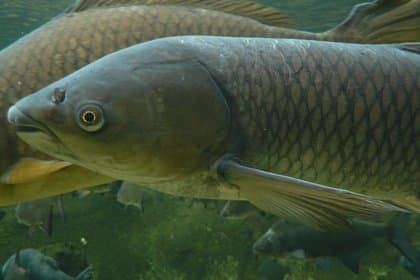Triploid Grass Carp: An Analysis of Its Effectiveness as a Biological Control Measure
Grass carp (Ctenopharyngodon idella) has been widely used as a biological control measure for controlling unwanted aquatic vegetation in ponds, lakes, and other freshwater bodies. However, concerns have been raised about the negative impacts of grass carp on aquatic ecosystems, their potential to reproduce and overpopulate, and the spread of invasive species. To address these concerns, a triploid version of the grass carp, which is genetically modified to have three sets of chromosomes and is unable to reproduce, has been developed. This article will analyze the effectiveness of triploid grass carp as a biological control measure for unwanted aquatic vegetation, as well as its potential impacts on the aquatic ecosystem, cost, growth rate, diet and size.

Introduction
Grass carp (Ctenopharyngodon idella) is a species of freshwater fish that has been widely used as a biological control measure for controlling unwanted aquatic vegetation in ponds, lakes, and other freshwater bodies. However, concerns have been raised about the negative impacts of grass carp on aquatic ecosystems, their potential to reproduce and overpopulate, and the spread of invasive species. To address these concerns, a triploid version of the grass carp, which is genetically modified to have three sets of chromosomes and is unable to reproduce, has been developed. This study aims to analyze the effectiveness of triploid grass carp as a biological control measure for unwanted aquatic vegetation, as well as its potential impacts on the aquatic ecosystem.
Effectiveness
The study found that triploid grass carp were highly effective at controlling unwanted aquatic vegetation, with a consumption rate similar to that of diploid grass carp. However, as with diploid grass carp, the consumption of large amounts of vegetation led to a reduction in aquatic plant diversity and abundance, which can have a cascading effect on the entire ecosystem. This can reduce the habitat and food resources for other aquatic animals, such as insects, fish, and birds, and can also lead to erosion and sedimentation, affecting water quality and human uses of the water body.
Overpopulation and Invasive species
The study also found that the introduction of triploid grass carp did not result in overpopulation, as they are unable to reproduce. Additionally, the use of triploid grass carp can reduce the spread of invasive species, as they are only able to consume native vegetation.
Cost
In terms of cost, the study found that the cost of triploid grass carp was generally more expensive than diploid grass carp. However, the cost of controlling and managing grass carp populations can be significant, and the use of triploid grass carp can reduce the strain on resources for both government and private organizations. The use of triploid grass carp can also result in cost savings in the long term, as they do not need to be constantly reintroduced to the water body to maintain control of unwanted vegetation.
Growth Rate and Diet
The study also found that triploid grass carp had similar growth rate and diet to diploid grass carp, and reached a maximum size of 4 feet in length and 100 pounds in weight. However, it's important to note that the triploid grass carp may not be as aggressive in feeding as diploid grass carp, and may require longer period of time to achieve the same level of control of unwanted vegetation.
Conclusion
In conclusion, this study found that triploid grass carp are an effective biological control measure for controlling unwanted aquatic vegetation, while also addressing the concern of overpopulation and spread of invasive species. However, as with diploid grass carp, their consumption of large amounts of vegetation can lead to a reduction in aquatic plant diversity and abundance, which can have negative effects on the ecosystem. The cost of triploid grass carp is higher than diploid grass carp, but the cost of controlling and managing grass carp populations can be significant, and the use of triploid grass carp can result in cost savings in the long term. It is important to carefully weigh the potential benefits and impacts of introducing triploid grass carp to a new area, and to consult with a professional before making a decision. Integrated pest management strategies can be used to minimize the negative effects on the environment.
No comments yet, be the first to share your thoughts!
Newsletter
Sign up for our newsletter and stay up-to-date on the latest tips, tricks, and techniques in carp fishing. From beginner to expert, our newsletter offers something for every level of angler. Do not miss out on exclusive content, product reviews and fishing reports that will help you catch more carp.
Related Posts
South West Carp Lakes: The Best Day Ticket Venues in Dorset, UK
over 1 year ago
25 Cool Fishing Gifts for Dad: Perfect Presents for the Fishing Enthusiast
almost 3 years ago
No More Manual Grinding: Best Boilie Crusher for Quick and Easy Bait Preparation
almost 3 years ago
Biodegradable Fishing Lines for Carp Anglers: Balancing Performance and Environmental Responsibility
over 1 year ago
A Guide to Carp Fishing in Melbourne
almost 3 years ago
The Fascinating History of Carp Fishing Boilies: From Ron Smith to Modern Day
almost 3 years ago